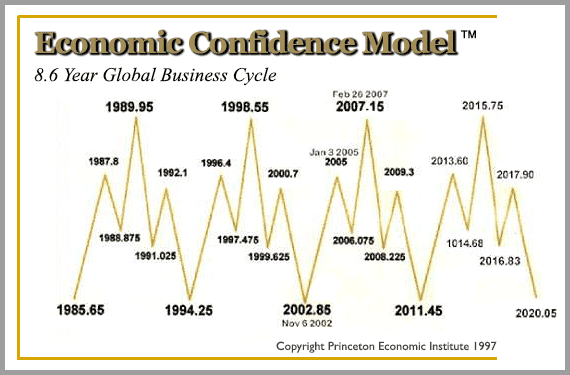Financial Sense Newshour had the recent privilege to speak with Martin Armstrong, the esteemed global strategist and creator of the widely-cited Economic Confidence Model (see image below), to explain how foreign capital flows may drive the dollar and US stocks into a massive bubble.
Here are a few excerpts from his interview that recently aired to our subscribers (click here for audio):
The ECB just announced a major stimulus program and we see the euro falling dramatically. Do you think this will make a big difference for their economy?
"No, not really...the real contraction in Europe is probably closer to about 6 trillion euros so it's nowhere near enough to offset the deflationary problems they have...we have to look at it from a practical ongoing perspective and the real crisis we have here is that we're in a sovereign debt bubble. This is global. How can we have a bailout and fix anything when you have governments issue debt with no intention of paying anything off and year after year they just issue more.”
“[Right now] people are running into the bond market and what our models are warning us is that this is a bond bubble. Just look at it objectively. We have interest rates at negative! So, let’s say we go into another recession—what are you going to do? Are you going to run to the government and say, ‘Please hold my money and I'll pay you 10%’? How far negative do you want to keep going here? It's getting to the point that it's just insane; and the dividends now on the S&P 500 have exceeded the 10-year bond rate so eventually you are going to have people go, 'Hmmm, I can make more money actually just on the dividends on average in stocks that I can in government bonds.'”
“Everybody else has been basically blowing themselves up...you have to look at it from serious money side: pension fund, etc. If I'm managing some pension fund and I'm managing a few hundred billion dollars and I want to park it, where can I park it?”
“If you're in the euro and the US stock market just opened and closed at the same price between the two days and the euro drops 10%, a foreign investor just made 10%...The foreigners they see US markets rising in terms of their currency...so it's the foreign capital coming in and you can see it other areas like real estate where they've been buying the high end stuff in New York City, Florida, California...it's all foreigners coming in and they're affecting a lot of different markets: the stock market, real estate, things of this nature.”
“We have three primary resistance targets. The first one is about 18,500 on the Dow. Until you really get through that area you're not really going to start to move sharply to the upside. The next one is about 23,000. After that, then we have a huge gap. Then there's the potential for what we would call a 'phase transition'. If we get through 23,000, you can go to 40,000. Why would that happen? Most likely, such phase transitions like that—like for example with Japan going into its final bubble—that type of move is usually indicative of foreign capital coming in...”
To hear this full 40-minute interview with Martin Armstrong and to gain unrestricted access to all our premium interviews and content, CLICK HERE to subscribe.
In the rest of this interview, Martin also explains:
- The importance of understanding capital flows and their impact on the market
- How capital flight from Europe into the US helped spur the stock market bubble before the Great Depression
- And what investors should expect to take place in the months and years ahead
For a list of previous interviews and guests, CLICK HERE to see our archive.






